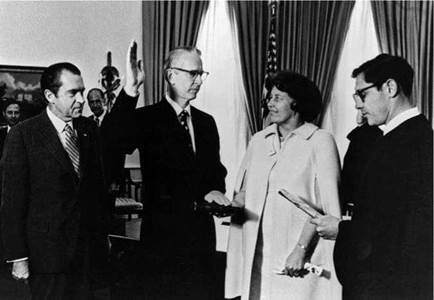National Security Uses of the Space Shuttle
Another of the influences on the choice of the full capability shuttle was President Nixon’s interest in its ability to launch the most advanced intelligence satellites and to carry out innovative national security missions. Those missions included the shuttle launching on demand during a political or military crisis, conducting a single-orbit satellite deployment or rendezvous, or inspecting or even destroying a potentially hostile satellite.
While the president himself may have been attracted by such national security uses, the reality was that support for the shuttle within the military and intelligence community was at best tepid, both at the time the shuttle decision was made and afterwards. Deputy Secretary of Defense David Packard’s 1971 flexibility on shuttle requirements is suggestive of an ambivalent Department of Defense attitude toward the vehicle, and the effort in late 1971 to get a joint NASA-DOD statement to the president in support of the shuttle apparently did not bear fruit. During 1972 Congressional hearings on the shuttle program, DOD and Air Force testimony was supportive but guarded in character; the military took the position that the DOD would commit to depending on the shuttle only after its capabilities and constant availability had been fully demonstrated. During the mid-1970s top-level Department of Defense support for the shuttle ebbed and flowed. At lower levels of the national security community, there was strong opposition to phasing out expendable launch vehicles until the shuttle was demonstrated to be completely reliable. The DOD did agree to pay the costs of a west coast launch site for the shuttle at Vandenberg Air Force Base, since that location was primarily needed for national security launches into polar orbit. In addition, DOD agreed to be responsible for funding the “space tug” to move payloads from the shuttle to higher orbits and for covering the costs of separate launch control centers in Houston and Colorado Springs for managing classified shuttle missions. With the urging of Hans Mark, first as Undersecretary and then as Secretary of the Air Force from 1977 to 1981, and for much of that time also director of the National Reconnaissance Office (NRO), some national security satellites were redesigned to take advantage of the shuttle’s attributes. When in 1979 President Jimmy Carter considered canceling the shuttle program because of its cost overruns, it was the national security uses of the shuttle, particularly in terms of launching the photo-reconnaissance satellites needed to verify arms control agreements, that convinced the president to continue the program. Once the Reagan administration took office in 1981, an early action was to confirm as national policy that the shuttle would be “the primary space launch system for both United States military and civilian government missions.”21
This policy declaration represented the high point of the notion of using the shuttle for national security missions. Within the first years of the Reagan administration, Air Force and NRO resistance to total dependence on the shuttle escalated into a conflict that required a presidential decision to resolve. The consequences of total U. S. dependence on the shuttle had been predicted. In the midst of the shuttle debate in 1971, the OMB had warned “for national security purposes, we may not want all our eggs in one basket.” The Air Force and NRO in 1984 won the right to develop an expendable launch vehicle as a backup to the shuttle for the largest national security payloads; this turned out to be the Titan IV booster. In the aftermath of the January 1986 Challenger accident, most national security payloads were removed from the shuttle and expendable launch vehicle production lines were activated; the nearly complete multibillion dollar West Coast launch site for the shuttle was mothballed.
Only ten dedicated national security missions, eight of which were classified, were launched aboard the space shuttle, including eight missions after the 1986 Challenger accident; the payloads for most of those missions had been uniquely designed for shuttle launch. Some of the capabilities relevant to national security uses, such as satellite repair, recovery, and refueling, were demonstrated on other early shuttle missions. But as a national security system, the shuttle had no continuing utility. One historian of national security space activities cites a Department of Defense 1992 report that set the cost of redesigning military and reconnaissance spacecraft first to launch on the shuttle and then reconfiguring them again to launch on the expensive Titan IV expendable launch vehicles after the Challenger accident as “in excess of $20 billion.”22 None of the ten national security shuttle missions required the cross-range capability that had been an original DOD demand, and none of the innovative missions described in the 1969 DOD/ NASA space shuttle report that had influenced Richard Nixon’s support of the NASA shuttle were ever attempted. Rather than provide new capabilities used by the national security community, the shuttle turned out to be a multibillion dollar drain on the national security space budget.











